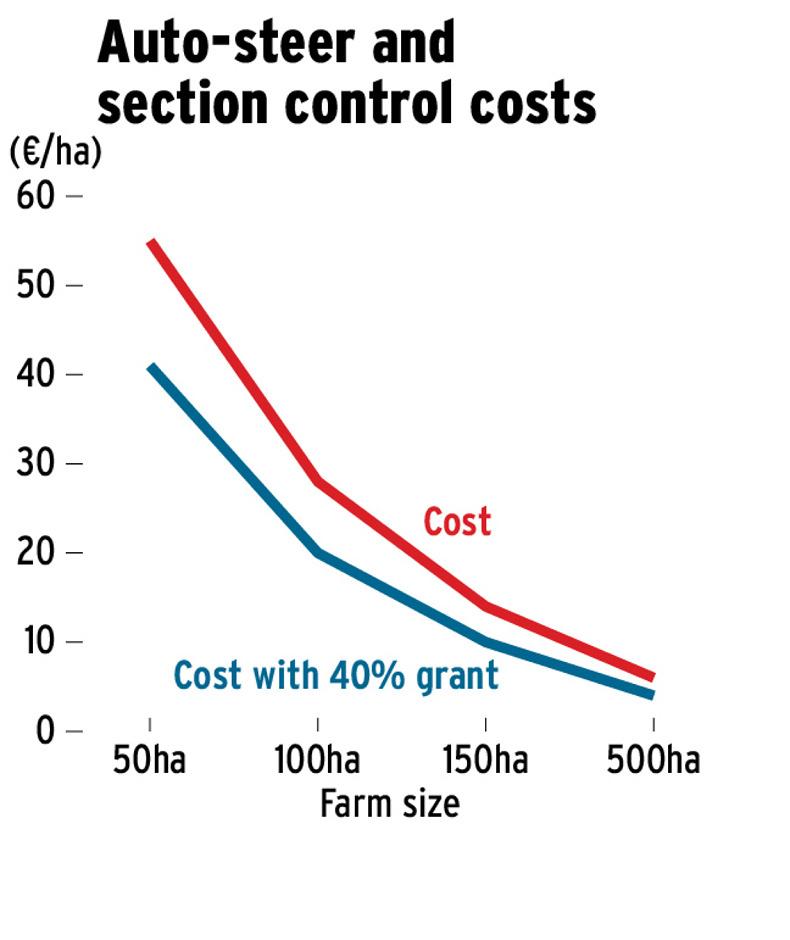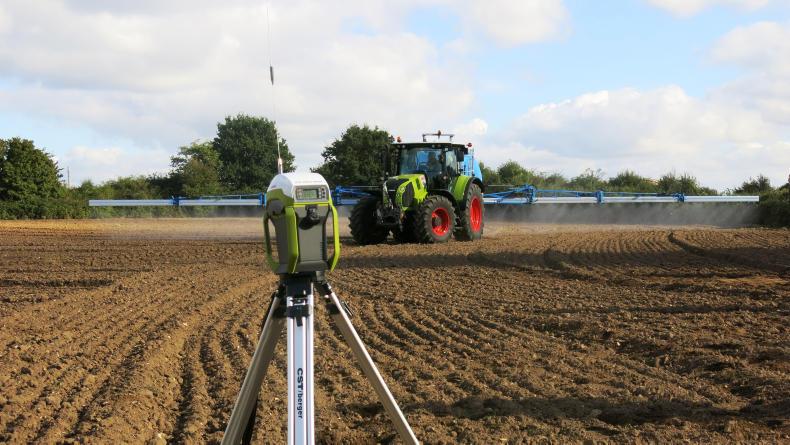The long-awaited TAMS II is tempting farmers into making investments in precision technology. But will it reap dividends? Dermot Forristal of Teagasc Oakpark has been analysing the use of GPS and other technologies on farms in Ireland.
He said: “Scale is the obvious factor in Ireland. Naturally, the larger farmers will see the most return in a short time period.”
Dermot used the example of just one component of smart farming, using an auto-steer system and section control on a sprayer. If the farmer invests a sum of €9,000 for GPS-controlled driving and €3,000 on section control fittings for the sprayer, Teagasc estimates on a 50ha cereal farm this will cost €55/ha over a five- to eight-year period. The investment should yield a return to the farmer of €16/ha in winter wheat and €8.76/ha in spring barley. The saving is calculated on the following assumptions:
Auto-steer with sectional control, based on field sizes ranging from 4-10ha with 300m runs
Correcting a 3m error at headland: 2% chemical saving.Reducing losses on four short runs: 0.5% chemical saving.Accurate tramline placement 24 v 23m: 4% chemical saving.The end result is a 6.5% saving on chemical, along with reduced water use and increased area capacity from the sprayer. In a winter wheat crop that leaves a deficit of €39/ha on the investment and €46.24 for spring barley. So clearly this investment will not make sense on a 50ha cereal farm.

The TAMS impact
So when does it make sense to invest in a system with auto control? In a TAMS approval scenario, this farmer has the potential to have the cost of investment reduced by €22/ha to €33/ha. This is still not near a breakeven point, and even at 60% funding for a young farmer the cost of the investment still leaves a deficit figure of €6/ha in winter wheat crops. That said, TAMS will make it a lot more affordable and a credible option for tillage farmers.
The breakeven point for investment on auto-steer and sectional control on a sprayer is a farm size of 150ha in winter wheat or 300ha of spring barley. TAMS funding approval for a farmer entitled to a 40% grant will reduce this area to just over 100ha for winter wheat and 200ha for spring barley.
However, a basic guidance system at €2,000 could be a shrewd investment. Systems with 25cm accuracy could be used for fertiliser application with section control, and for marking in tramlines.
Under TAMS the cost of a basic GPS unit could come in around the €1,000 mark or just €6.60 for the 50ha tillage farmer. If the farmer saves one 50kg bag of fertiliser per hectare, it will yield a return of €18/ha, giving an increase in margin of €11.40. Based on this scenario, the unit will have paid for itself in two years on a 50ha cereal farm. This figure excludes any depreciation, maintenance or training.
The benefit for the contractor
The question asked at last week’s FTMTA Farm Machinery Show was how a contractor will benefit from this investment in auto-steer technology. Will they get an extra payment from the farmer for saving on seed, fertiliser and chemical? That will depend on how the farmer sees the service. Can he determine the value of the reduced inputs needed by the contractor when sowing, spraying or fertilising the crops on the farm? From the contractor’s viewpoint, this technology will allow them to work off accurate land areas for payment. In theory, the jobs could be achieved with fewer field passes, saving on fuel and machine wear. Combine this with reduced driver fatigue and the ability to work longer more efficient hours. The figures for contractor savings are not available from Teagasc as no work has been completed in this area.
Conclusion
Based on advice from Dermot, and the Teagasc figures on investment costs, farmers should spend relative to the size of the farm. Smaller farms are not in a position to make any financial gain by investment in top-end technology. They can get good results with basic entry level GPS. Larger scale farms should be considering auto-steering and sectional controls. Apart from accurate driving and application rates, technology also allows farmers to ascertain field records easier than before. Every farm is different, and investment should be made to suit the system in place and the size of the farm.
The long-awaited TAMS II is tempting farmers into making investments in precision technology. But will it reap dividends? Dermot Forristal of Teagasc Oakpark has been analysing the use of GPS and other technologies on farms in Ireland.
He said: “Scale is the obvious factor in Ireland. Naturally, the larger farmers will see the most return in a short time period.”
Dermot used the example of just one component of smart farming, using an auto-steer system and section control on a sprayer. If the farmer invests a sum of €9,000 for GPS-controlled driving and €3,000 on section control fittings for the sprayer, Teagasc estimates on a 50ha cereal farm this will cost €55/ha over a five- to eight-year period. The investment should yield a return to the farmer of €16/ha in winter wheat and €8.76/ha in spring barley. The saving is calculated on the following assumptions:
Auto-steer with sectional control, based on field sizes ranging from 4-10ha with 300m runs
Correcting a 3m error at headland: 2% chemical saving.Reducing losses on four short runs: 0.5% chemical saving.Accurate tramline placement 24 v 23m: 4% chemical saving.The end result is a 6.5% saving on chemical, along with reduced water use and increased area capacity from the sprayer. In a winter wheat crop that leaves a deficit of €39/ha on the investment and €46.24 for spring barley. So clearly this investment will not make sense on a 50ha cereal farm.

The TAMS impact
So when does it make sense to invest in a system with auto control? In a TAMS approval scenario, this farmer has the potential to have the cost of investment reduced by €22/ha to €33/ha. This is still not near a breakeven point, and even at 60% funding for a young farmer the cost of the investment still leaves a deficit figure of €6/ha in winter wheat crops. That said, TAMS will make it a lot more affordable and a credible option for tillage farmers.
The breakeven point for investment on auto-steer and sectional control on a sprayer is a farm size of 150ha in winter wheat or 300ha of spring barley. TAMS funding approval for a farmer entitled to a 40% grant will reduce this area to just over 100ha for winter wheat and 200ha for spring barley.
However, a basic guidance system at €2,000 could be a shrewd investment. Systems with 25cm accuracy could be used for fertiliser application with section control, and for marking in tramlines.
Under TAMS the cost of a basic GPS unit could come in around the €1,000 mark or just €6.60 for the 50ha tillage farmer. If the farmer saves one 50kg bag of fertiliser per hectare, it will yield a return of €18/ha, giving an increase in margin of €11.40. Based on this scenario, the unit will have paid for itself in two years on a 50ha cereal farm. This figure excludes any depreciation, maintenance or training.
The benefit for the contractor
The question asked at last week’s FTMTA Farm Machinery Show was how a contractor will benefit from this investment in auto-steer technology. Will they get an extra payment from the farmer for saving on seed, fertiliser and chemical? That will depend on how the farmer sees the service. Can he determine the value of the reduced inputs needed by the contractor when sowing, spraying or fertilising the crops on the farm? From the contractor’s viewpoint, this technology will allow them to work off accurate land areas for payment. In theory, the jobs could be achieved with fewer field passes, saving on fuel and machine wear. Combine this with reduced driver fatigue and the ability to work longer more efficient hours. The figures for contractor savings are not available from Teagasc as no work has been completed in this area.
Conclusion
Based on advice from Dermot, and the Teagasc figures on investment costs, farmers should spend relative to the size of the farm. Smaller farms are not in a position to make any financial gain by investment in top-end technology. They can get good results with basic entry level GPS. Larger scale farms should be considering auto-steering and sectional controls. Apart from accurate driving and application rates, technology also allows farmers to ascertain field records easier than before. Every farm is different, and investment should be made to suit the system in place and the size of the farm.







 This is a subscriber-only article
This is a subscriber-only article










SHARING OPTIONS: